Brand Management Report: Brand Equity and Management at Dyson
VerifiedAdded on 2023/01/06
|21
|6803
|42
Report
AI Summary
This report delves into the intricacies of brand management, utilizing Dyson as a comprehensive case study. The introduction defines brand management and its significance in enhancing the perceived value of goods and services, emphasizing its role in building customer loyalty and brand awareness. Task 1 explores the importance of branding as a marketing tool, examining how branding has evolved in business practices and the key components of a successful brand strategy, including market research, competition analysis, and value proposition development. The report uses Aaker's brand equity model to analyze Dyson's brand awareness, loyalty, perceived quality, brand associations, and intellectual properties. Task 2 analyzes various strategies for portfolio management, brand hierarchy, and brand equity management, with critical analysis using appropriate theories and frameworks. Task 3 evaluates collaborative brand management at both domestic and global levels, critically assessing different techniques used to leverage and extend brands. Task 4 assesses techniques for measuring and managing brand value, using specific organizational examples to develop stronger and enduring brand value, and concludes with a critical evaluation of branding within an organizational context.

Brand Management
Paraphrase This Document
Need a fresh take? Get an instant paraphrase of this document with our AI Paraphraser
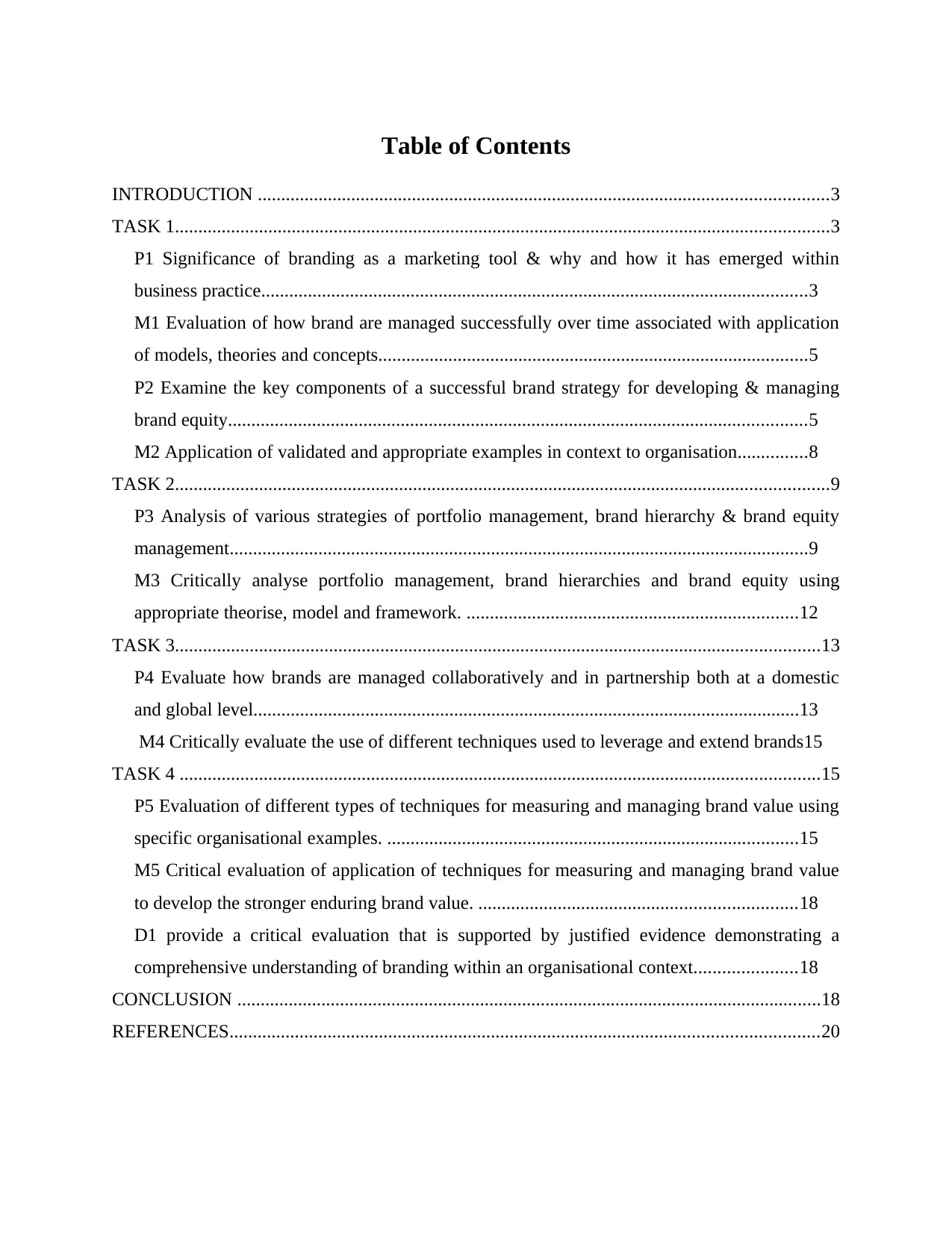
Table of Contents
INTRODUCTION ..........................................................................................................................3
TASK 1............................................................................................................................................3
P1 Significance of branding as a marketing tool & why and how it has emerged within
business practice.....................................................................................................................3
M1 Evaluation of how brand are managed successfully over time associated with application
of models, theories and concepts............................................................................................5
P2 Examine the key components of a successful brand strategy for developing & managing
brand equity............................................................................................................................5
M2 Application of validated and appropriate examples in context to organisation...............8
TASK 2............................................................................................................................................9
P3 Analysis of various strategies of portfolio management, brand hierarchy & brand equity
management............................................................................................................................9
M3 Critically analyse portfolio management, brand hierarchies and brand equity using
appropriate theorise, model and framework. .......................................................................12
TASK 3..........................................................................................................................................13
P4 Evaluate how brands are managed collaboratively and in partnership both at a domestic
and global level.....................................................................................................................13
M4 Critically evaluate the use of different techniques used to leverage and extend brands15
TASK 4 .........................................................................................................................................15
P5 Evaluation of different types of techniques for measuring and managing brand value using
specific organisational examples. ........................................................................................15
M5 Critical evaluation of application of techniques for measuring and managing brand value
to develop the stronger enduring brand value. ....................................................................18
D1 provide a critical evaluation that is supported by justified evidence demonstrating a
comprehensive understanding of branding within an organisational context......................18
CONCLUSION .............................................................................................................................18
REFERENCES..............................................................................................................................20
INTRODUCTION ..........................................................................................................................3
TASK 1............................................................................................................................................3
P1 Significance of branding as a marketing tool & why and how it has emerged within
business practice.....................................................................................................................3
M1 Evaluation of how brand are managed successfully over time associated with application
of models, theories and concepts............................................................................................5
P2 Examine the key components of a successful brand strategy for developing & managing
brand equity............................................................................................................................5
M2 Application of validated and appropriate examples in context to organisation...............8
TASK 2............................................................................................................................................9
P3 Analysis of various strategies of portfolio management, brand hierarchy & brand equity
management............................................................................................................................9
M3 Critically analyse portfolio management, brand hierarchies and brand equity using
appropriate theorise, model and framework. .......................................................................12
TASK 3..........................................................................................................................................13
P4 Evaluate how brands are managed collaboratively and in partnership both at a domestic
and global level.....................................................................................................................13
M4 Critically evaluate the use of different techniques used to leverage and extend brands15
TASK 4 .........................................................................................................................................15
P5 Evaluation of different types of techniques for measuring and managing brand value using
specific organisational examples. ........................................................................................15
M5 Critical evaluation of application of techniques for measuring and managing brand value
to develop the stronger enduring brand value. ....................................................................18
D1 provide a critical evaluation that is supported by justified evidence demonstrating a
comprehensive understanding of branding within an organisational context......................18
CONCLUSION .............................................................................................................................18
REFERENCES..............................................................................................................................20
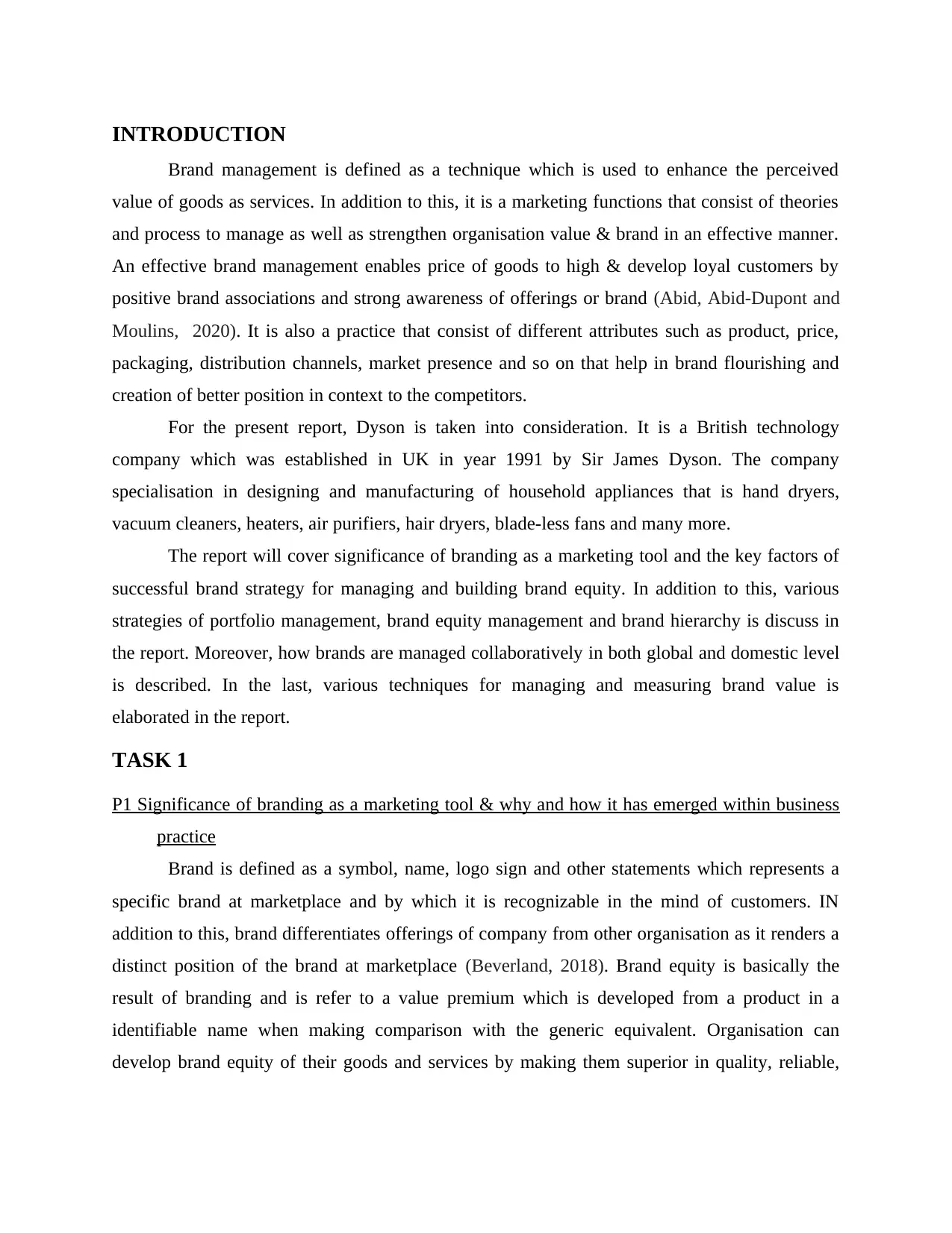
INTRODUCTION
Brand management is defined as a technique which is used to enhance the perceived
value of goods as services. In addition to this, it is a marketing functions that consist of theories
and process to manage as well as strengthen organisation value & brand in an effective manner.
An effective brand management enables price of goods to high & develop loyal customers by
positive brand associations and strong awareness of offerings or brand (Abid, Abid‐Dupont and
Moulins, 2020). It is also a practice that consist of different attributes such as product, price,
packaging, distribution channels, market presence and so on that help in brand flourishing and
creation of better position in context to the competitors.
For the present report, Dyson is taken into consideration. It is a British technology
company which was established in UK in year 1991 by Sir James Dyson. The company
specialisation in designing and manufacturing of household appliances that is hand dryers,
vacuum cleaners, heaters, air purifiers, hair dryers, blade-less fans and many more.
The report will cover significance of branding as a marketing tool and the key factors of
successful brand strategy for managing and building brand equity. In addition to this, various
strategies of portfolio management, brand equity management and brand hierarchy is discuss in
the report. Moreover, how brands are managed collaboratively in both global and domestic level
is described. In the last, various techniques for managing and measuring brand value is
elaborated in the report.
TASK 1
P1 Significance of branding as a marketing tool & why and how it has emerged within business
practice
Brand is defined as a symbol, name, logo sign and other statements which represents a
specific brand at marketplace and by which it is recognizable in the mind of customers. IN
addition to this, brand differentiates offerings of company from other organisation as it renders a
distinct position of the brand at marketplace (Beverland, 2018). Brand equity is basically the
result of branding and is refer to a value premium which is developed from a product in a
identifiable name when making comparison with the generic equivalent. Organisation can
develop brand equity of their goods and services by making them superior in quality, reliable,
Brand management is defined as a technique which is used to enhance the perceived
value of goods as services. In addition to this, it is a marketing functions that consist of theories
and process to manage as well as strengthen organisation value & brand in an effective manner.
An effective brand management enables price of goods to high & develop loyal customers by
positive brand associations and strong awareness of offerings or brand (Abid, Abid‐Dupont and
Moulins, 2020). It is also a practice that consist of different attributes such as product, price,
packaging, distribution channels, market presence and so on that help in brand flourishing and
creation of better position in context to the competitors.
For the present report, Dyson is taken into consideration. It is a British technology
company which was established in UK in year 1991 by Sir James Dyson. The company
specialisation in designing and manufacturing of household appliances that is hand dryers,
vacuum cleaners, heaters, air purifiers, hair dryers, blade-less fans and many more.
The report will cover significance of branding as a marketing tool and the key factors of
successful brand strategy for managing and building brand equity. In addition to this, various
strategies of portfolio management, brand equity management and brand hierarchy is discuss in
the report. Moreover, how brands are managed collaboratively in both global and domestic level
is described. In the last, various techniques for managing and measuring brand value is
elaborated in the report.
TASK 1
P1 Significance of branding as a marketing tool & why and how it has emerged within business
practice
Brand is defined as a symbol, name, logo sign and other statements which represents a
specific brand at marketplace and by which it is recognizable in the mind of customers. IN
addition to this, brand differentiates offerings of company from other organisation as it renders a
distinct position of the brand at marketplace (Beverland, 2018). Brand equity is basically the
result of branding and is refer to a value premium which is developed from a product in a
identifiable name when making comparison with the generic equivalent. Organisation can
develop brand equity of their goods and services by making them superior in quality, reliable,
⊘ This is a preview!⊘
Do you want full access?
Subscribe today to unlock all pages.

Trusted by 1+ million students worldwide
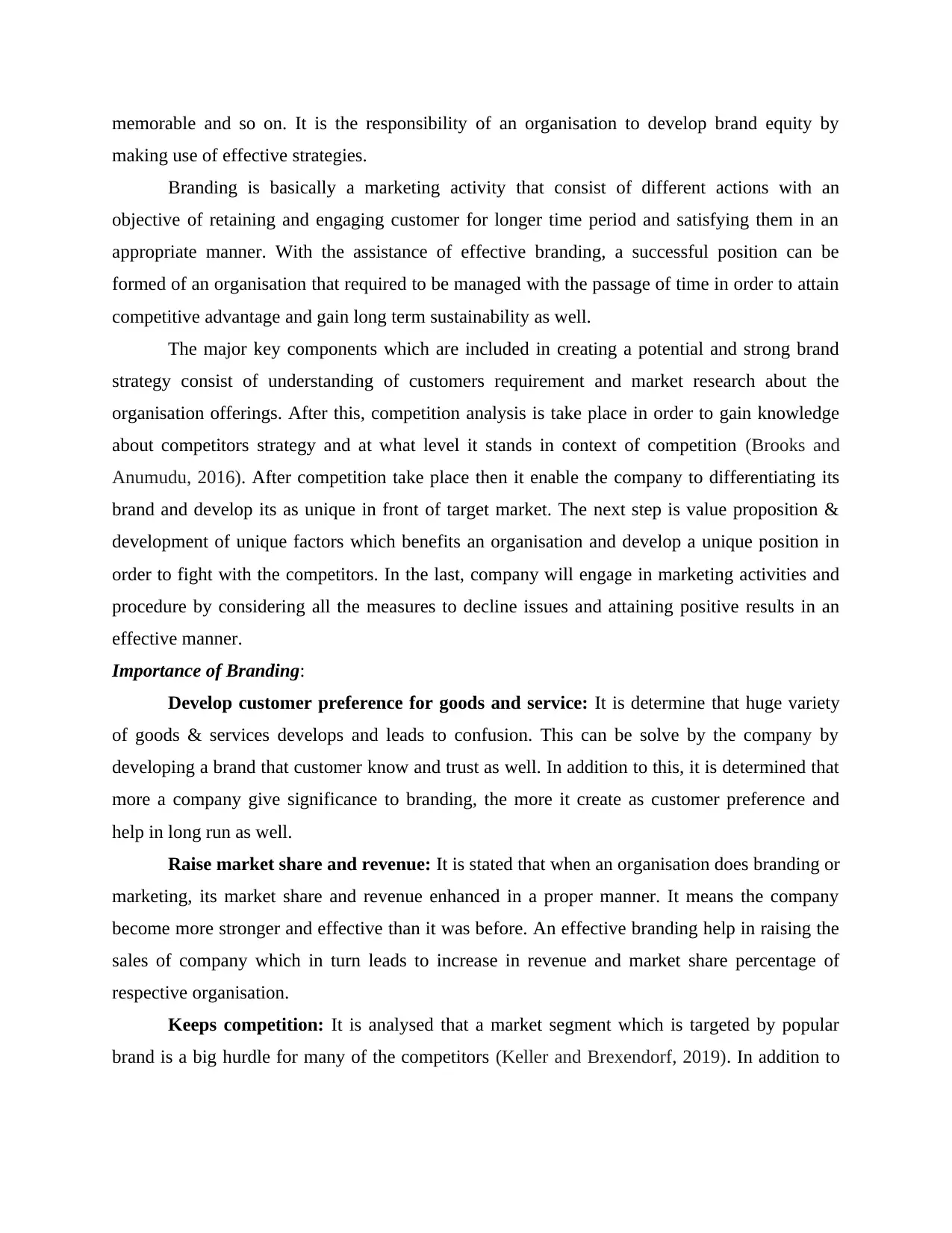
memorable and so on. It is the responsibility of an organisation to develop brand equity by
making use of effective strategies.
Branding is basically a marketing activity that consist of different actions with an
objective of retaining and engaging customer for longer time period and satisfying them in an
appropriate manner. With the assistance of effective branding, a successful position can be
formed of an organisation that required to be managed with the passage of time in order to attain
competitive advantage and gain long term sustainability as well.
The major key components which are included in creating a potential and strong brand
strategy consist of understanding of customers requirement and market research about the
organisation offerings. After this, competition analysis is take place in order to gain knowledge
about competitors strategy and at what level it stands in context of competition (Brooks and
Anumudu, 2016). After competition take place then it enable the company to differentiating its
brand and develop its as unique in front of target market. The next step is value proposition &
development of unique factors which benefits an organisation and develop a unique position in
order to fight with the competitors. In the last, company will engage in marketing activities and
procedure by considering all the measures to decline issues and attaining positive results in an
effective manner.
Importance of Branding:
Develop customer preference for goods and service: It is determine that huge variety
of goods & services develops and leads to confusion. This can be solve by the company by
developing a brand that customer know and trust as well. In addition to this, it is determined that
more a company give significance to branding, the more it create as customer preference and
help in long run as well.
Raise market share and revenue: It is stated that when an organisation does branding or
marketing, its market share and revenue enhanced in a proper manner. It means the company
become more stronger and effective than it was before. An effective branding help in raising the
sales of company which in turn leads to increase in revenue and market share percentage of
respective organisation.
Keeps competition: It is analysed that a market segment which is targeted by popular
brand is a big hurdle for many of the competitors (Keller and Brexendorf, 2019). In addition to
making use of effective strategies.
Branding is basically a marketing activity that consist of different actions with an
objective of retaining and engaging customer for longer time period and satisfying them in an
appropriate manner. With the assistance of effective branding, a successful position can be
formed of an organisation that required to be managed with the passage of time in order to attain
competitive advantage and gain long term sustainability as well.
The major key components which are included in creating a potential and strong brand
strategy consist of understanding of customers requirement and market research about the
organisation offerings. After this, competition analysis is take place in order to gain knowledge
about competitors strategy and at what level it stands in context of competition (Brooks and
Anumudu, 2016). After competition take place then it enable the company to differentiating its
brand and develop its as unique in front of target market. The next step is value proposition &
development of unique factors which benefits an organisation and develop a unique position in
order to fight with the competitors. In the last, company will engage in marketing activities and
procedure by considering all the measures to decline issues and attaining positive results in an
effective manner.
Importance of Branding:
Develop customer preference for goods and service: It is determine that huge variety
of goods & services develops and leads to confusion. This can be solve by the company by
developing a brand that customer know and trust as well. In addition to this, it is determined that
more a company give significance to branding, the more it create as customer preference and
help in long run as well.
Raise market share and revenue: It is stated that when an organisation does branding or
marketing, its market share and revenue enhanced in a proper manner. It means the company
become more stronger and effective than it was before. An effective branding help in raising the
sales of company which in turn leads to increase in revenue and market share percentage of
respective organisation.
Keeps competition: It is analysed that a market segment which is targeted by popular
brand is a big hurdle for many of the competitors (Keller and Brexendorf, 2019). In addition to
Paraphrase This Document
Need a fresh take? Get an instant paraphrase of this document with our AI Paraphraser
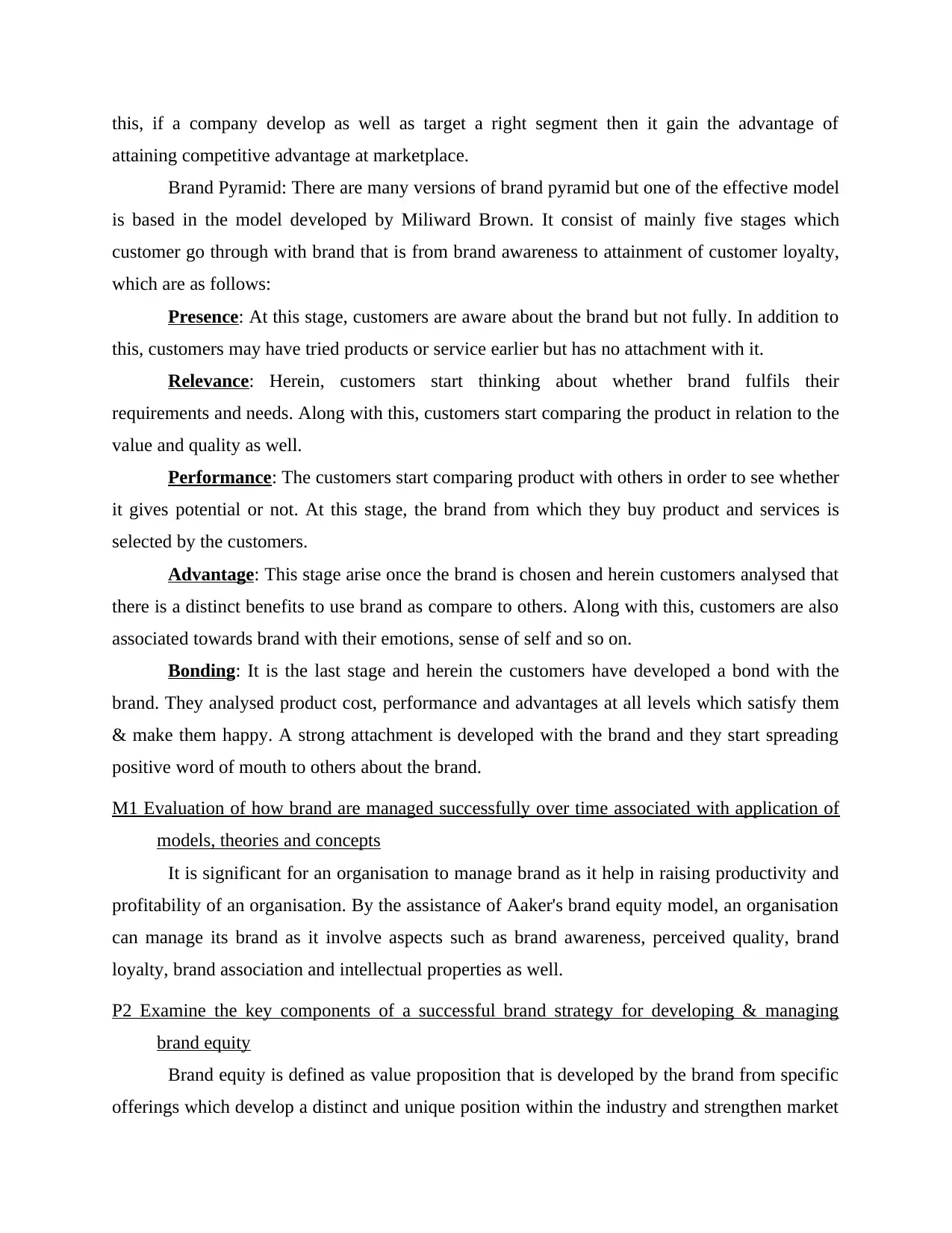
this, if a company develop as well as target a right segment then it gain the advantage of
attaining competitive advantage at marketplace.
Brand Pyramid: There are many versions of brand pyramid but one of the effective model
is based in the model developed by Miliward Brown. It consist of mainly five stages which
customer go through with brand that is from brand awareness to attainment of customer loyalty,
which are as follows:
Presence: At this stage, customers are aware about the brand but not fully. In addition to
this, customers may have tried products or service earlier but has no attachment with it.
Relevance: Herein, customers start thinking about whether brand fulfils their
requirements and needs. Along with this, customers start comparing the product in relation to the
value and quality as well.
Performance: The customers start comparing product with others in order to see whether
it gives potential or not. At this stage, the brand from which they buy product and services is
selected by the customers.
Advantage: This stage arise once the brand is chosen and herein customers analysed that
there is a distinct benefits to use brand as compare to others. Along with this, customers are also
associated towards brand with their emotions, sense of self and so on.
Bonding: It is the last stage and herein the customers have developed a bond with the
brand. They analysed product cost, performance and advantages at all levels which satisfy them
& make them happy. A strong attachment is developed with the brand and they start spreading
positive word of mouth to others about the brand.
M1 Evaluation of how brand are managed successfully over time associated with application of
models, theories and concepts
It is significant for an organisation to manage brand as it help in raising productivity and
profitability of an organisation. By the assistance of Aaker's brand equity model, an organisation
can manage its brand as it involve aspects such as brand awareness, perceived quality, brand
loyalty, brand association and intellectual properties as well.
P2 Examine the key components of a successful brand strategy for developing & managing
brand equity
Brand equity is defined as value proposition that is developed by the brand from specific
offerings which develop a distinct and unique position within the industry and strengthen market
attaining competitive advantage at marketplace.
Brand Pyramid: There are many versions of brand pyramid but one of the effective model
is based in the model developed by Miliward Brown. It consist of mainly five stages which
customer go through with brand that is from brand awareness to attainment of customer loyalty,
which are as follows:
Presence: At this stage, customers are aware about the brand but not fully. In addition to
this, customers may have tried products or service earlier but has no attachment with it.
Relevance: Herein, customers start thinking about whether brand fulfils their
requirements and needs. Along with this, customers start comparing the product in relation to the
value and quality as well.
Performance: The customers start comparing product with others in order to see whether
it gives potential or not. At this stage, the brand from which they buy product and services is
selected by the customers.
Advantage: This stage arise once the brand is chosen and herein customers analysed that
there is a distinct benefits to use brand as compare to others. Along with this, customers are also
associated towards brand with their emotions, sense of self and so on.
Bonding: It is the last stage and herein the customers have developed a bond with the
brand. They analysed product cost, performance and advantages at all levels which satisfy them
& make them happy. A strong attachment is developed with the brand and they start spreading
positive word of mouth to others about the brand.
M1 Evaluation of how brand are managed successfully over time associated with application of
models, theories and concepts
It is significant for an organisation to manage brand as it help in raising productivity and
profitability of an organisation. By the assistance of Aaker's brand equity model, an organisation
can manage its brand as it involve aspects such as brand awareness, perceived quality, brand
loyalty, brand association and intellectual properties as well.
P2 Examine the key components of a successful brand strategy for developing & managing
brand equity
Brand equity is defined as value proposition that is developed by the brand from specific
offerings which develop a distinct and unique position within the industry and strengthen market
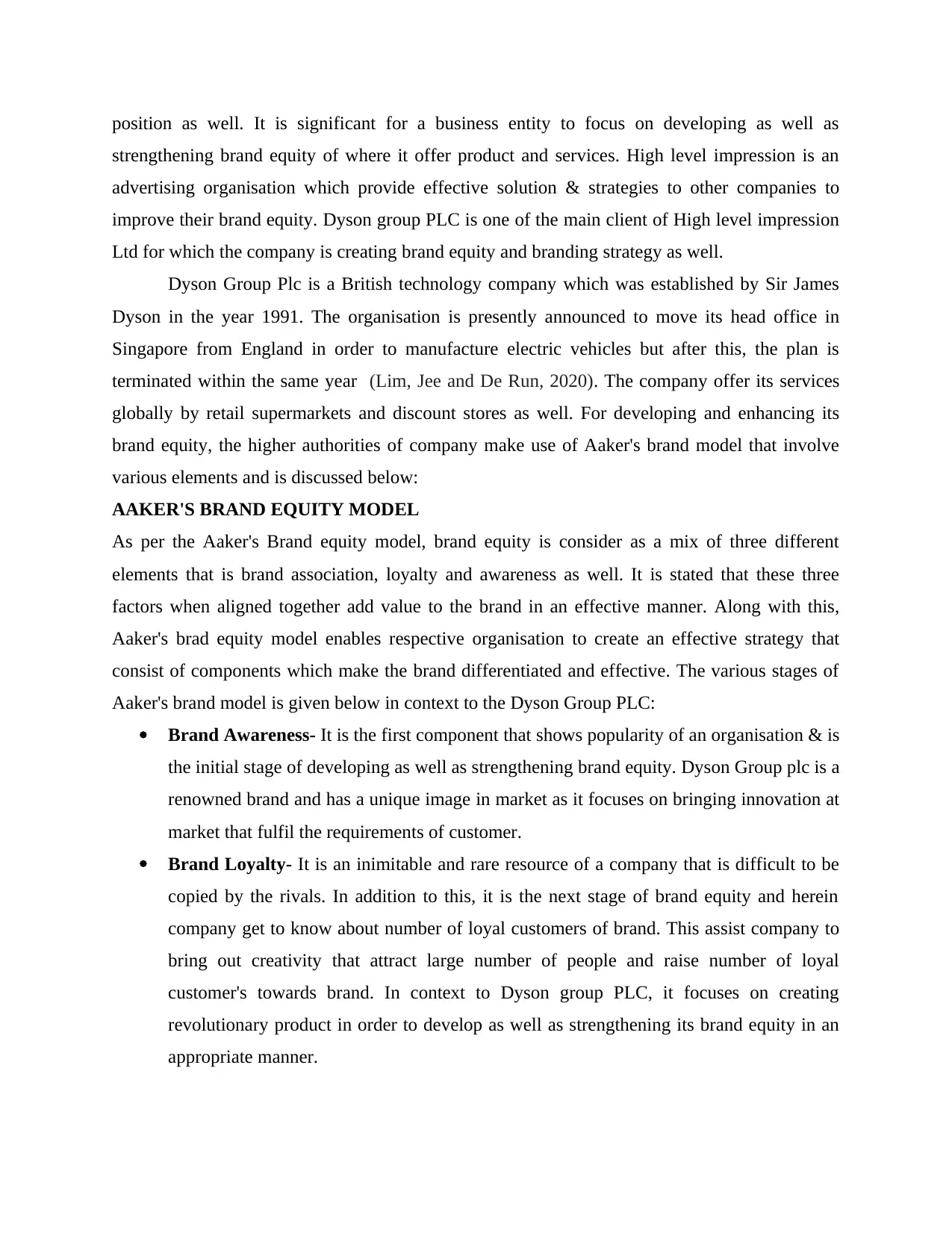
position as well. It is significant for a business entity to focus on developing as well as
strengthening brand equity of where it offer product and services. High level impression is an
advertising organisation which provide effective solution & strategies to other companies to
improve their brand equity. Dyson group PLC is one of the main client of High level impression
Ltd for which the company is creating brand equity and branding strategy as well.
Dyson Group Plc is a British technology company which was established by Sir James
Dyson in the year 1991. The organisation is presently announced to move its head office in
Singapore from England in order to manufacture electric vehicles but after this, the plan is
terminated within the same year (Lim, Jee and De Run, 2020). The company offer its services
globally by retail supermarkets and discount stores as well. For developing and enhancing its
brand equity, the higher authorities of company make use of Aaker's brand model that involve
various elements and is discussed below:
AAKER'S BRAND EQUITY MODEL
As per the Aaker's Brand equity model, brand equity is consider as a mix of three different
elements that is brand association, loyalty and awareness as well. It is stated that these three
factors when aligned together add value to the brand in an effective manner. Along with this,
Aaker's brad equity model enables respective organisation to create an effective strategy that
consist of components which make the brand differentiated and effective. The various stages of
Aaker's brand model is given below in context to the Dyson Group PLC:
Brand Awareness- It is the first component that shows popularity of an organisation & is
the initial stage of developing as well as strengthening brand equity. Dyson Group plc is a
renowned brand and has a unique image in market as it focuses on bringing innovation at
market that fulfil the requirements of customer.
Brand Loyalty- It is an inimitable and rare resource of a company that is difficult to be
copied by the rivals. In addition to this, it is the next stage of brand equity and herein
company get to know about number of loyal customers of brand. This assist company to
bring out creativity that attract large number of people and raise number of loyal
customer's towards brand. In context to Dyson group PLC, it focuses on creating
revolutionary product in order to develop as well as strengthening its brand equity in an
appropriate manner.
strengthening brand equity of where it offer product and services. High level impression is an
advertising organisation which provide effective solution & strategies to other companies to
improve their brand equity. Dyson group PLC is one of the main client of High level impression
Ltd for which the company is creating brand equity and branding strategy as well.
Dyson Group Plc is a British technology company which was established by Sir James
Dyson in the year 1991. The organisation is presently announced to move its head office in
Singapore from England in order to manufacture electric vehicles but after this, the plan is
terminated within the same year (Lim, Jee and De Run, 2020). The company offer its services
globally by retail supermarkets and discount stores as well. For developing and enhancing its
brand equity, the higher authorities of company make use of Aaker's brand model that involve
various elements and is discussed below:
AAKER'S BRAND EQUITY MODEL
As per the Aaker's Brand equity model, brand equity is consider as a mix of three different
elements that is brand association, loyalty and awareness as well. It is stated that these three
factors when aligned together add value to the brand in an effective manner. Along with this,
Aaker's brad equity model enables respective organisation to create an effective strategy that
consist of components which make the brand differentiated and effective. The various stages of
Aaker's brand model is given below in context to the Dyson Group PLC:
Brand Awareness- It is the first component that shows popularity of an organisation & is
the initial stage of developing as well as strengthening brand equity. Dyson Group plc is a
renowned brand and has a unique image in market as it focuses on bringing innovation at
market that fulfil the requirements of customer.
Brand Loyalty- It is an inimitable and rare resource of a company that is difficult to be
copied by the rivals. In addition to this, it is the next stage of brand equity and herein
company get to know about number of loyal customers of brand. This assist company to
bring out creativity that attract large number of people and raise number of loyal
customer's towards brand. In context to Dyson group PLC, it focuses on creating
revolutionary product in order to develop as well as strengthening its brand equity in an
appropriate manner.
⊘ This is a preview!⊘
Do you want full access?
Subscribe today to unlock all pages.

Trusted by 1+ million students worldwide
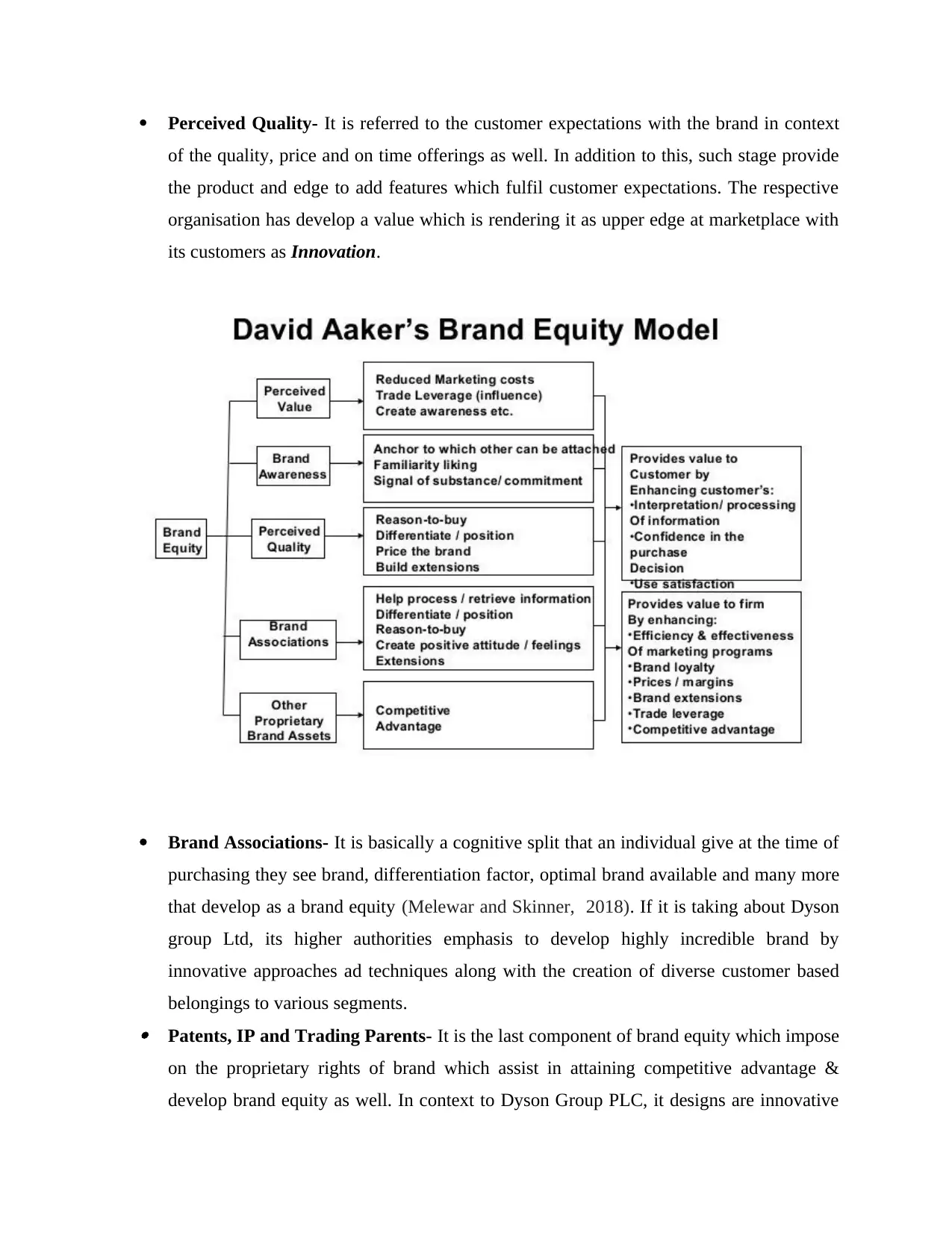
Perceived Quality- It is referred to the customer expectations with the brand in context
of the quality, price and on time offerings as well. In addition to this, such stage provide
the product and edge to add features which fulfil customer expectations. The respective
organisation has develop a value which is rendering it as upper edge at marketplace with
its customers as Innovation.
Brand Associations- It is basically a cognitive split that an individual give at the time of
purchasing they see brand, differentiation factor, optimal brand available and many more
that develop as a brand equity (Melewar and Skinner, 2018). If it is taking about Dyson
group Ltd, its higher authorities emphasis to develop highly incredible brand by
innovative approaches ad techniques along with the creation of diverse customer based
belongings to various segments. Patents, IP and Trading Parents- It is the last component of brand equity which impose
on the proprietary rights of brand which assist in attaining competitive advantage &
develop brand equity as well. In context to Dyson Group PLC, it designs are innovative
of the quality, price and on time offerings as well. In addition to this, such stage provide
the product and edge to add features which fulfil customer expectations. The respective
organisation has develop a value which is rendering it as upper edge at marketplace with
its customers as Innovation.
Brand Associations- It is basically a cognitive split that an individual give at the time of
purchasing they see brand, differentiation factor, optimal brand available and many more
that develop as a brand equity (Melewar and Skinner, 2018). If it is taking about Dyson
group Ltd, its higher authorities emphasis to develop highly incredible brand by
innovative approaches ad techniques along with the creation of diverse customer based
belongings to various segments. Patents, IP and Trading Parents- It is the last component of brand equity which impose
on the proprietary rights of brand which assist in attaining competitive advantage &
develop brand equity as well. In context to Dyson Group PLC, it designs are innovative
Paraphrase This Document
Need a fresh take? Get an instant paraphrase of this document with our AI Paraphraser
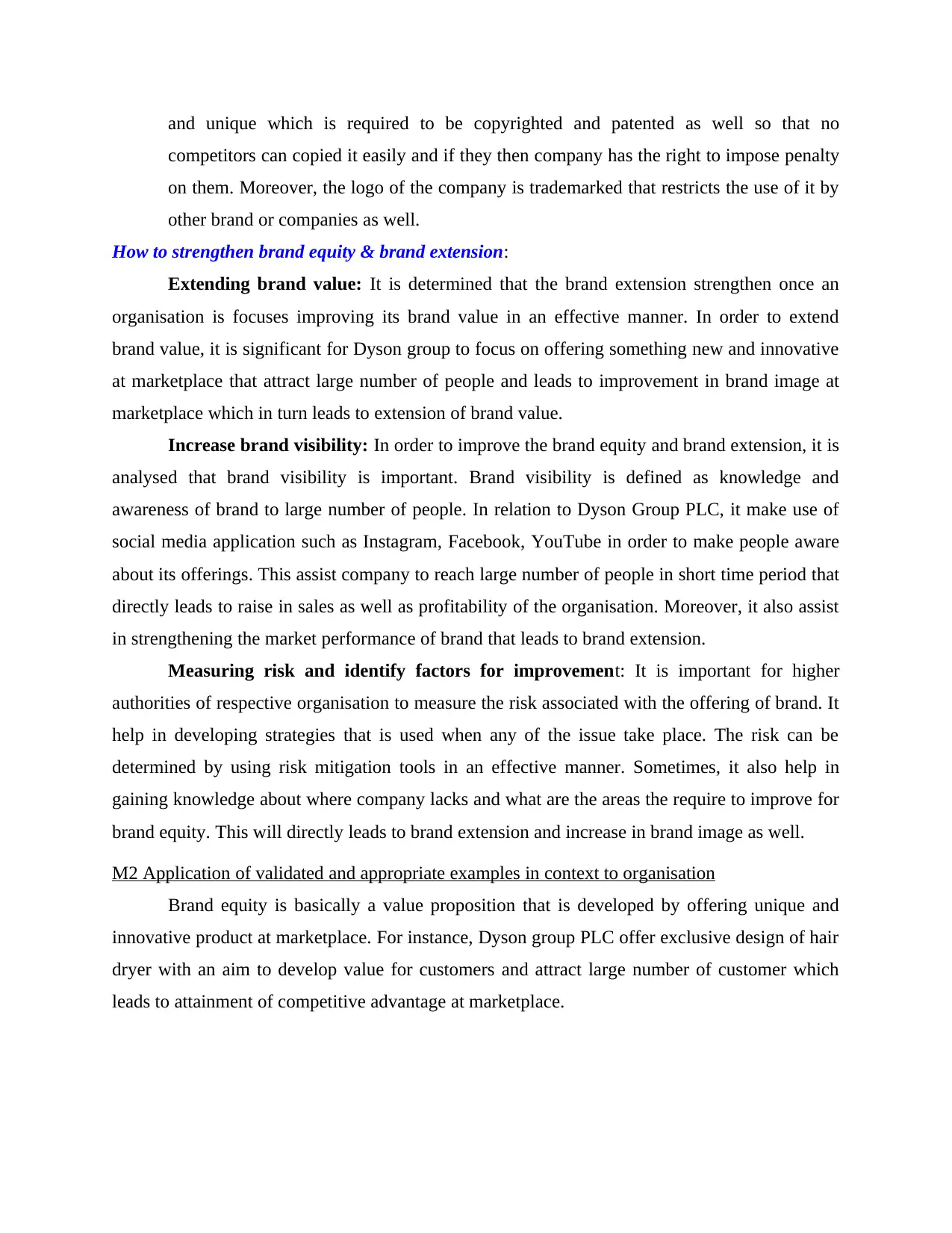
and unique which is required to be copyrighted and patented as well so that no
competitors can copied it easily and if they then company has the right to impose penalty
on them. Moreover, the logo of the company is trademarked that restricts the use of it by
other brand or companies as well.
How to strengthen brand equity & brand extension:
Extending brand value: It is determined that the brand extension strengthen once an
organisation is focuses improving its brand value in an effective manner. In order to extend
brand value, it is significant for Dyson group to focus on offering something new and innovative
at marketplace that attract large number of people and leads to improvement in brand image at
marketplace which in turn leads to extension of brand value.
Increase brand visibility: In order to improve the brand equity and brand extension, it is
analysed that brand visibility is important. Brand visibility is defined as knowledge and
awareness of brand to large number of people. In relation to Dyson Group PLC, it make use of
social media application such as Instagram, Facebook, YouTube in order to make people aware
about its offerings. This assist company to reach large number of people in short time period that
directly leads to raise in sales as well as profitability of the organisation. Moreover, it also assist
in strengthening the market performance of brand that leads to brand extension.
Measuring risk and identify factors for improvement: It is important for higher
authorities of respective organisation to measure the risk associated with the offering of brand. It
help in developing strategies that is used when any of the issue take place. The risk can be
determined by using risk mitigation tools in an effective manner. Sometimes, it also help in
gaining knowledge about where company lacks and what are the areas the require to improve for
brand equity. This will directly leads to brand extension and increase in brand image as well.
M2 Application of validated and appropriate examples in context to organisation
Brand equity is basically a value proposition that is developed by offering unique and
innovative product at marketplace. For instance, Dyson group PLC offer exclusive design of hair
dryer with an aim to develop value for customers and attract large number of customer which
leads to attainment of competitive advantage at marketplace.
competitors can copied it easily and if they then company has the right to impose penalty
on them. Moreover, the logo of the company is trademarked that restricts the use of it by
other brand or companies as well.
How to strengthen brand equity & brand extension:
Extending brand value: It is determined that the brand extension strengthen once an
organisation is focuses improving its brand value in an effective manner. In order to extend
brand value, it is significant for Dyson group to focus on offering something new and innovative
at marketplace that attract large number of people and leads to improvement in brand image at
marketplace which in turn leads to extension of brand value.
Increase brand visibility: In order to improve the brand equity and brand extension, it is
analysed that brand visibility is important. Brand visibility is defined as knowledge and
awareness of brand to large number of people. In relation to Dyson Group PLC, it make use of
social media application such as Instagram, Facebook, YouTube in order to make people aware
about its offerings. This assist company to reach large number of people in short time period that
directly leads to raise in sales as well as profitability of the organisation. Moreover, it also assist
in strengthening the market performance of brand that leads to brand extension.
Measuring risk and identify factors for improvement: It is important for higher
authorities of respective organisation to measure the risk associated with the offering of brand. It
help in developing strategies that is used when any of the issue take place. The risk can be
determined by using risk mitigation tools in an effective manner. Sometimes, it also help in
gaining knowledge about where company lacks and what are the areas the require to improve for
brand equity. This will directly leads to brand extension and increase in brand image as well.
M2 Application of validated and appropriate examples in context to organisation
Brand equity is basically a value proposition that is developed by offering unique and
innovative product at marketplace. For instance, Dyson group PLC offer exclusive design of hair
dryer with an aim to develop value for customers and attract large number of customer which
leads to attainment of competitive advantage at marketplace.
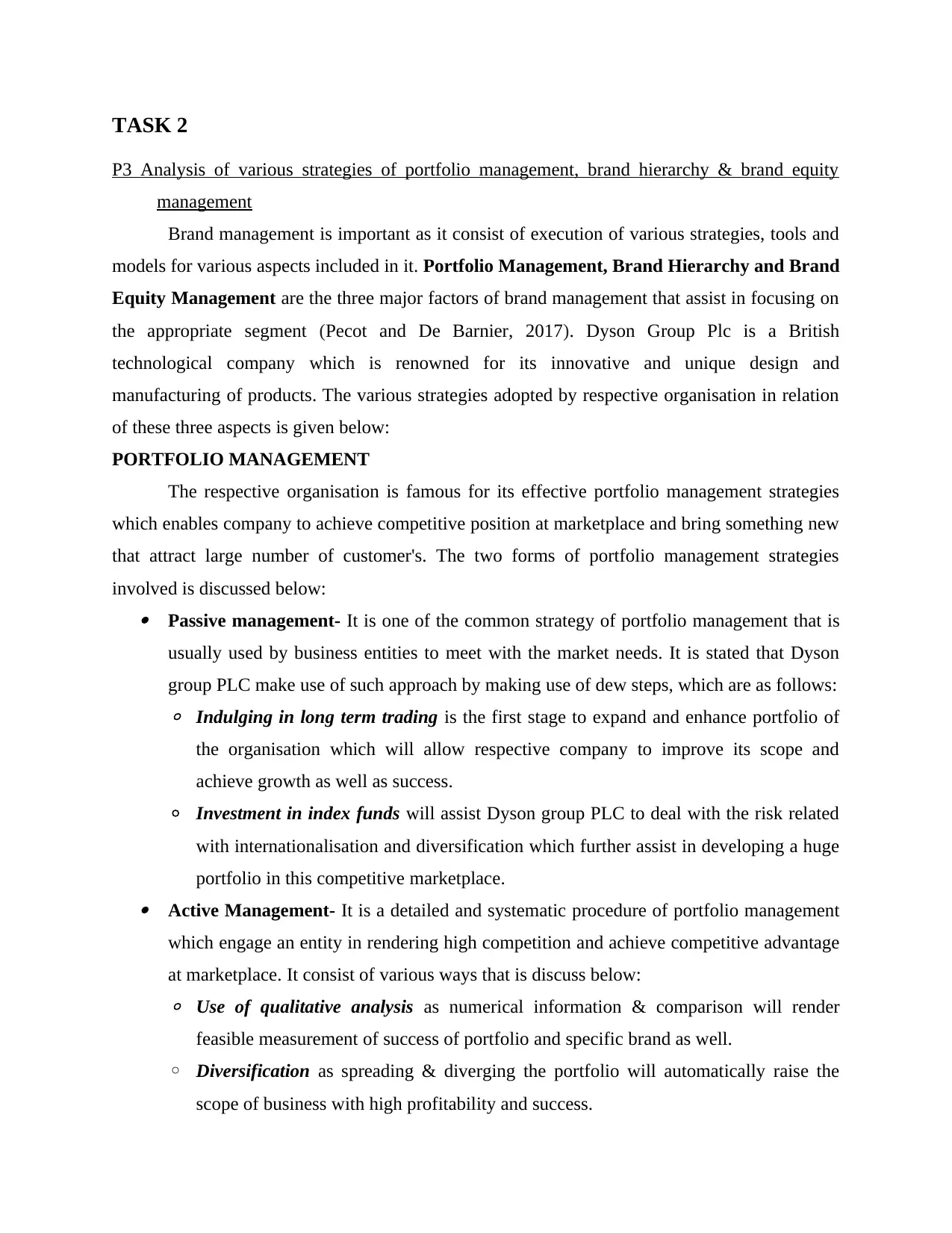
TASK 2
P3 Analysis of various strategies of portfolio management, brand hierarchy & brand equity
management
Brand management is important as it consist of execution of various strategies, tools and
models for various aspects included in it. Portfolio Management, Brand Hierarchy and Brand
Equity Management are the three major factors of brand management that assist in focusing on
the appropriate segment (Pecot and De Barnier, 2017). Dyson Group Plc is a British
technological company which is renowned for its innovative and unique design and
manufacturing of products. The various strategies adopted by respective organisation in relation
of these three aspects is given below:
PORTFOLIO MANAGEMENT
The respective organisation is famous for its effective portfolio management strategies
which enables company to achieve competitive position at marketplace and bring something new
that attract large number of customer's. The two forms of portfolio management strategies
involved is discussed below: Passive management- It is one of the common strategy of portfolio management that is
usually used by business entities to meet with the market needs. It is stated that Dyson
group PLC make use of such approach by making use of dew steps, which are as follows:
◦ Indulging in long term trading is the first stage to expand and enhance portfolio of
the organisation which will allow respective company to improve its scope and
achieve growth as well as success.
◦ Investment in index funds will assist Dyson group PLC to deal with the risk related
with internationalisation and diversification which further assist in developing a huge
portfolio in this competitive marketplace. Active Management- It is a detailed and systematic procedure of portfolio management
which engage an entity in rendering high competition and achieve competitive advantage
at marketplace. It consist of various ways that is discuss below:
◦ Use of qualitative analysis as numerical information & comparison will render
feasible measurement of success of portfolio and specific brand as well.
◦ Diversification as spreading & diverging the portfolio will automatically raise the
scope of business with high profitability and success.
P3 Analysis of various strategies of portfolio management, brand hierarchy & brand equity
management
Brand management is important as it consist of execution of various strategies, tools and
models for various aspects included in it. Portfolio Management, Brand Hierarchy and Brand
Equity Management are the three major factors of brand management that assist in focusing on
the appropriate segment (Pecot and De Barnier, 2017). Dyson Group Plc is a British
technological company which is renowned for its innovative and unique design and
manufacturing of products. The various strategies adopted by respective organisation in relation
of these three aspects is given below:
PORTFOLIO MANAGEMENT
The respective organisation is famous for its effective portfolio management strategies
which enables company to achieve competitive position at marketplace and bring something new
that attract large number of customer's. The two forms of portfolio management strategies
involved is discussed below: Passive management- It is one of the common strategy of portfolio management that is
usually used by business entities to meet with the market needs. It is stated that Dyson
group PLC make use of such approach by making use of dew steps, which are as follows:
◦ Indulging in long term trading is the first stage to expand and enhance portfolio of
the organisation which will allow respective company to improve its scope and
achieve growth as well as success.
◦ Investment in index funds will assist Dyson group PLC to deal with the risk related
with internationalisation and diversification which further assist in developing a huge
portfolio in this competitive marketplace. Active Management- It is a detailed and systematic procedure of portfolio management
which engage an entity in rendering high competition and achieve competitive advantage
at marketplace. It consist of various ways that is discuss below:
◦ Use of qualitative analysis as numerical information & comparison will render
feasible measurement of success of portfolio and specific brand as well.
◦ Diversification as spreading & diverging the portfolio will automatically raise the
scope of business with high profitability and success.
⊘ This is a preview!⊘
Do you want full access?
Subscribe today to unlock all pages.

Trusted by 1+ million students worldwide

By analysing the techniques of portfolio management, it is analysed that Dyson group
PLC make use of active management strategy as it assist in making effective comparison at
various markers and results into quantifiable information.
BRAND HIERARCHY
It is referred as a systematic and effective series of offerings which sell in market under
the name of an organisation that involve same logo (Razak, 2020). It involve various strategies
that is given below in context to respective company:
Brand House- In this method, the business entity act as a brand & other brand which are
sub parts of company are not associated with the mean brand.
House of Brands- In this approach, the sub brands are different from organisation & the
emphasis of the parent brand is to aware its sub brands instead of focusing on its own
brand.
PLC make use of active management strategy as it assist in making effective comparison at
various markers and results into quantifiable information.
BRAND HIERARCHY
It is referred as a systematic and effective series of offerings which sell in market under
the name of an organisation that involve same logo (Razak, 2020). It involve various strategies
that is given below in context to respective company:
Brand House- In this method, the business entity act as a brand & other brand which are
sub parts of company are not associated with the mean brand.
House of Brands- In this approach, the sub brands are different from organisation & the
emphasis of the parent brand is to aware its sub brands instead of focusing on its own
brand.
Paraphrase This Document
Need a fresh take? Get an instant paraphrase of this document with our AI Paraphraser
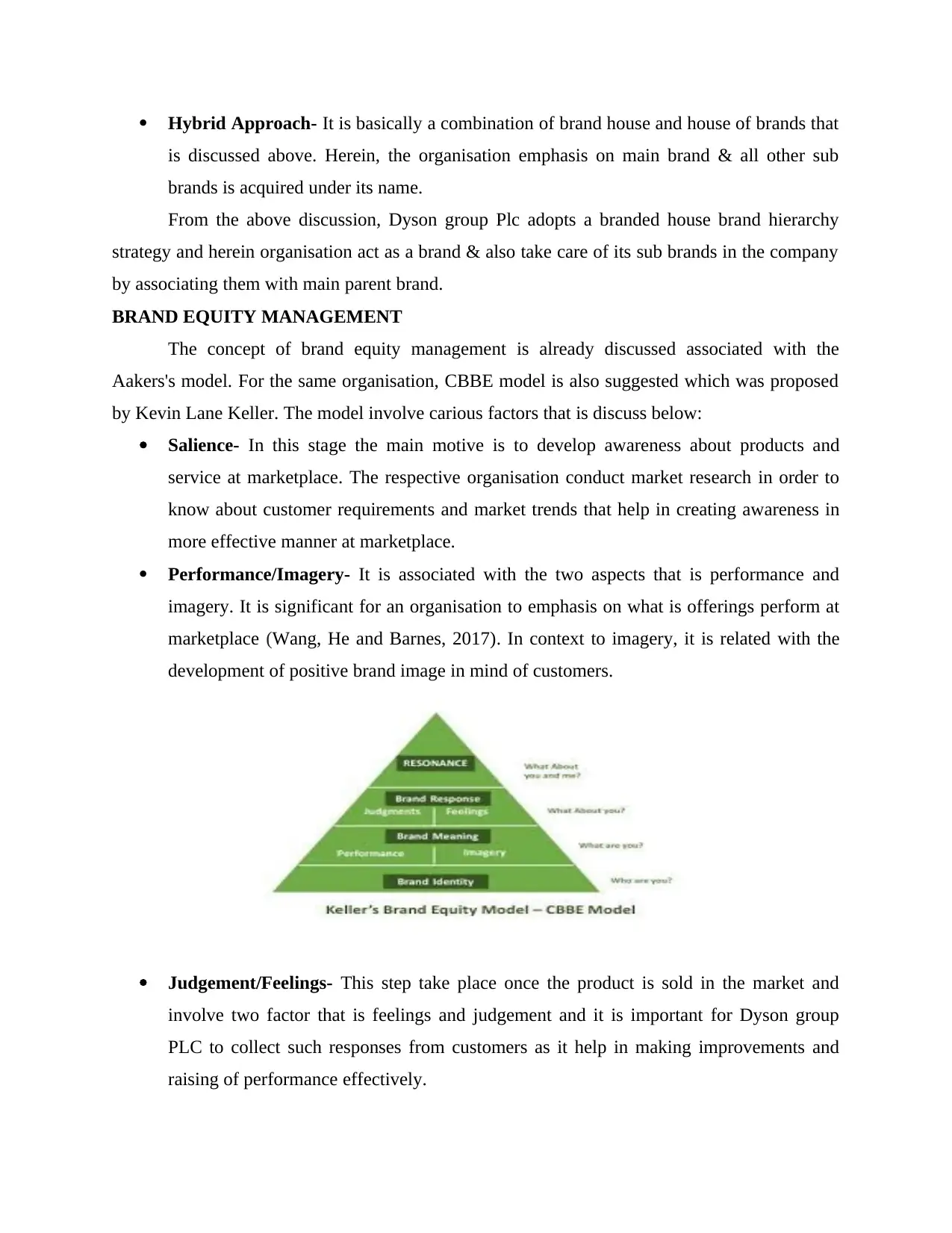
Hybrid Approach- It is basically a combination of brand house and house of brands that
is discussed above. Herein, the organisation emphasis on main brand & all other sub
brands is acquired under its name.
From the above discussion, Dyson group Plc adopts a branded house brand hierarchy
strategy and herein organisation act as a brand & also take care of its sub brands in the company
by associating them with main parent brand.
BRAND EQUITY MANAGEMENT
The concept of brand equity management is already discussed associated with the
Aakers's model. For the same organisation, CBBE model is also suggested which was proposed
by Kevin Lane Keller. The model involve carious factors that is discuss below:
Salience- In this stage the main motive is to develop awareness about products and
service at marketplace. The respective organisation conduct market research in order to
know about customer requirements and market trends that help in creating awareness in
more effective manner at marketplace.
Performance/Imagery- It is associated with the two aspects that is performance and
imagery. It is significant for an organisation to emphasis on what is offerings perform at
marketplace (Wang, He and Barnes, 2017). In context to imagery, it is related with the
development of positive brand image in mind of customers.
Judgement/Feelings- This step take place once the product is sold in the market and
involve two factor that is feelings and judgement and it is important for Dyson group
PLC to collect such responses from customers as it help in making improvements and
raising of performance effectively.
is discussed above. Herein, the organisation emphasis on main brand & all other sub
brands is acquired under its name.
From the above discussion, Dyson group Plc adopts a branded house brand hierarchy
strategy and herein organisation act as a brand & also take care of its sub brands in the company
by associating them with main parent brand.
BRAND EQUITY MANAGEMENT
The concept of brand equity management is already discussed associated with the
Aakers's model. For the same organisation, CBBE model is also suggested which was proposed
by Kevin Lane Keller. The model involve carious factors that is discuss below:
Salience- In this stage the main motive is to develop awareness about products and
service at marketplace. The respective organisation conduct market research in order to
know about customer requirements and market trends that help in creating awareness in
more effective manner at marketplace.
Performance/Imagery- It is associated with the two aspects that is performance and
imagery. It is significant for an organisation to emphasis on what is offerings perform at
marketplace (Wang, He and Barnes, 2017). In context to imagery, it is related with the
development of positive brand image in mind of customers.
Judgement/Feelings- This step take place once the product is sold in the market and
involve two factor that is feelings and judgement and it is important for Dyson group
PLC to collect such responses from customers as it help in making improvements and
raising of performance effectively.
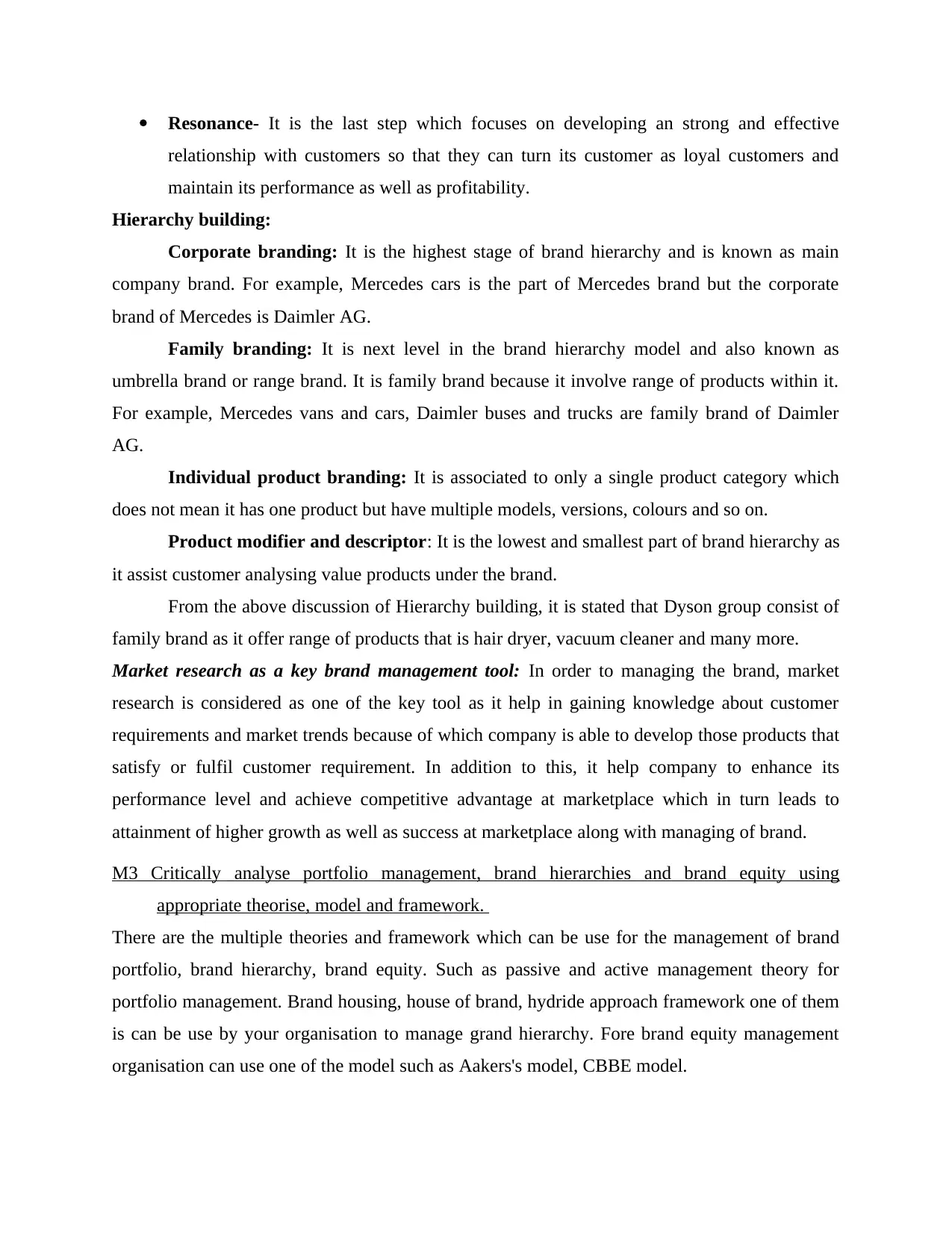
Resonance- It is the last step which focuses on developing an strong and effective
relationship with customers so that they can turn its customer as loyal customers and
maintain its performance as well as profitability.
Hierarchy building:
Corporate branding: It is the highest stage of brand hierarchy and is known as main
company brand. For example, Mercedes cars is the part of Mercedes brand but the corporate
brand of Mercedes is Daimler AG.
Family branding: It is next level in the brand hierarchy model and also known as
umbrella brand or range brand. It is family brand because it involve range of products within it.
For example, Mercedes vans and cars, Daimler buses and trucks are family brand of Daimler
AG.
Individual product branding: It is associated to only a single product category which
does not mean it has one product but have multiple models, versions, colours and so on.
Product modifier and descriptor: It is the lowest and smallest part of brand hierarchy as
it assist customer analysing value products under the brand.
From the above discussion of Hierarchy building, it is stated that Dyson group consist of
family brand as it offer range of products that is hair dryer, vacuum cleaner and many more.
Market research as a key brand management tool: In order to managing the brand, market
research is considered as one of the key tool as it help in gaining knowledge about customer
requirements and market trends because of which company is able to develop those products that
satisfy or fulfil customer requirement. In addition to this, it help company to enhance its
performance level and achieve competitive advantage at marketplace which in turn leads to
attainment of higher growth as well as success at marketplace along with managing of brand.
M3 Critically analyse portfolio management, brand hierarchies and brand equity using
appropriate theorise, model and framework.
There are the multiple theories and framework which can be use for the management of brand
portfolio, brand hierarchy, brand equity. Such as passive and active management theory for
portfolio management. Brand housing, house of brand, hydride approach framework one of them
is can be use by your organisation to manage grand hierarchy. Fore brand equity management
organisation can use one of the model such as Aakers's model, CBBE model.
relationship with customers so that they can turn its customer as loyal customers and
maintain its performance as well as profitability.
Hierarchy building:
Corporate branding: It is the highest stage of brand hierarchy and is known as main
company brand. For example, Mercedes cars is the part of Mercedes brand but the corporate
brand of Mercedes is Daimler AG.
Family branding: It is next level in the brand hierarchy model and also known as
umbrella brand or range brand. It is family brand because it involve range of products within it.
For example, Mercedes vans and cars, Daimler buses and trucks are family brand of Daimler
AG.
Individual product branding: It is associated to only a single product category which
does not mean it has one product but have multiple models, versions, colours and so on.
Product modifier and descriptor: It is the lowest and smallest part of brand hierarchy as
it assist customer analysing value products under the brand.
From the above discussion of Hierarchy building, it is stated that Dyson group consist of
family brand as it offer range of products that is hair dryer, vacuum cleaner and many more.
Market research as a key brand management tool: In order to managing the brand, market
research is considered as one of the key tool as it help in gaining knowledge about customer
requirements and market trends because of which company is able to develop those products that
satisfy or fulfil customer requirement. In addition to this, it help company to enhance its
performance level and achieve competitive advantage at marketplace which in turn leads to
attainment of higher growth as well as success at marketplace along with managing of brand.
M3 Critically analyse portfolio management, brand hierarchies and brand equity using
appropriate theorise, model and framework.
There are the multiple theories and framework which can be use for the management of brand
portfolio, brand hierarchy, brand equity. Such as passive and active management theory for
portfolio management. Brand housing, house of brand, hydride approach framework one of them
is can be use by your organisation to manage grand hierarchy. Fore brand equity management
organisation can use one of the model such as Aakers's model, CBBE model.
⊘ This is a preview!⊘
Do you want full access?
Subscribe today to unlock all pages.

Trusted by 1+ million students worldwide
1 out of 21
Related Documents
Your All-in-One AI-Powered Toolkit for Academic Success.
+13062052269
info@desklib.com
Available 24*7 on WhatsApp / Email
![[object Object]](/_next/static/media/star-bottom.7253800d.svg)
Unlock your academic potential
Copyright © 2020–2025 A2Z Services. All Rights Reserved. Developed and managed by ZUCOL.




